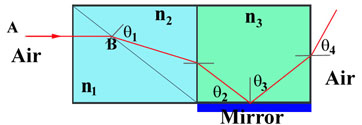



A light ray follows the path shown in the above figure. Given that n1 = 1.7, n2 = 1.5, n3 = 1.3, and q(theta) = 60o, determine the anglesq1, q2, q3, and q4. Assume that the index of refraction for air is 1.0 and path AB is parallel to the base of the figure.
